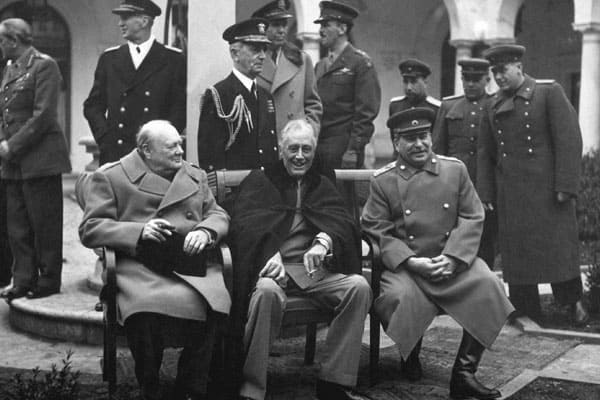Three wartime conferences that changed the world
Three major summits during World War II between the heads of state of the major Allied powers changed the world for future generations: these wartime conferences were crucial to help maintain peace, following one of the most horrific conflicts in history.
Delegates at the conferences in Tehran, Yalta and Potsdam discussed how to move forward and the progress of the post-war world. They were attended by the Allied powers known as the “Big Three”: Britain, the United States and the Soviet Union.

The aim of the meetings was to shape post-war peace in a way that recognised a collective security order, while devising a plan to give the liberated people of Europe self-determination for their future.
Earlier in the war, the alliance between the UK, the US and the Soviet Union operated mainly through correspondence and bilateral conferences. However, as the conflict continued, the heads of government of the three major Allied powers made plans to come together for a series of crucial meetings.
Tehran
The Tehran conference was the first of the three conferences. It was held between 28th November and 1st December 1943 in the Iranian capital. The Prime Minister of Britain Winston Churchill met US President Franklin Roosevelt and the Premier of the Soviet Union Joseph Stalin. It was the first time the trio had all attended a meeting together to discuss military strategies and the world order post-war.
While Churchill had met with Stalin and Roosevelt separately on earlier occasions, the summit was the first face-to-face meeting between the Soviet and US leaders. They discussed military issues, including the timing of a Soviet entry into the war against Japan and the institutional foundation of a new organisation to maintain international security and peace after the war.
The idea had been agreed, in principle, by foreign ministers at an earlier meeting.
Yalta
The Yalta Conference held in a Russian town in the Crimea, saw Churchill, Roosevelt and Stalin make important decisions about the progress of the war and the post-war world. The meeting was held between February 4th and 11th 1945. It was the second time the Big Three had met in person.
The end of the war was in sight, with victory for the Allies seeming likely. Discussions were focused on reorganising the Continent after the war. The Allies reaffirmed their determination to pursue the complete surrender of Germany, with plans to divide the nation into occupied zones afterwards.
Other topics of debate included the punishment of war criminals and the future international organisation set to replace the League of Nations, the United Nations. They discussed voting procedures for the new organisation. The war in Asia was also discussed, as that was continuing despite the war in Europe nearing its conclusion.
With hindsight, modern-day historians believe Yalta left the most controversial legacy due to the conclusions reached, particularly those concerning eastern Europe. Churchill and Roosevelt recognised the strong position of the Soviet Army. Consequently, they agreed to several compromises with Stalin that permitted Soviet dominance over several Eastern European countries. They also granted the Soviet Union territorial concessions and determined punitive measures against Germany.
Potsdam
The final meeting of the Big Three took place at Potsdam in Germany from 17th July to 2nd August 1945, after Victory in Europe Day on 8th May. This meeting provided an inkling of the tension that would eventually lead to the Cold War.
Despite the war in Europe having ended and the Allies having knowledge of the existence of the atomic bomb, the three leaders couldn’t agree on the majority of the issues on the table. By this time, Roosevelt had passed away and had been replaced by Harry Truman as US President.
Midway through the conference, Churchill was replaced by his successor Clement Attlee, who had come to power on 26th July as a result of a general election in the UK. Neither Truman nor Attlee could see eye-to-eye with Stalin.
The most important agreement they made was to issue the Potsdam Declaration to Japan. It demanded an unconditional and immediate surrender. If Japan didn’t comply, the Allies threatened the nation with destruction.
What happened after the war?
Following the end of WWII, once the Axis powers had been defeated, the wartime alliance began to collapse. Sadly, it deteriorated into suspicion and bitterness.
One reason was because the Big Three faced significant challenges to coordinate their efforts. Their capital cities were separated by thousands of miles.
While the Big Three had met in person during the war, this didn’t continue in peacetime. Making important decisions by the two main forms of communication, telegraph and telephone, wasn’t ideal.
In addition, while Roosevelt had readily worked with Stalin, mainly because the war in Japan was still continuing, Truman barely disguised his dislike of Communism and of Stalin himself.
By the beginning of the 1960s, the Cold War entered its most serious phase, and the world was pushed to the brink of nuclear war. Today, with the conflict in Ukraine, sadly, peace seems a long way off at present.
&Meetings will be joining with people across the world at 11 am on 11th November, when we will be observing the 2-minute silence. We will always remember and pay our respects to those who have made the ultimate sacrifice in all conflicts.
Share this post
Tags
- Career Development
- Celebrity Meetings
- Conferences
- Confidence
- Exhibitions
- Historic Meetings
- How to Interview Effectively
- Human Resources
- In The Press
- Meetings and Conferences
- Monarchy
- News
- Our Team
- Personal Development
- Personnel
- Presentation Techniques
- Teamwork
- Top Tips for Meetings
- Training & Workshops
- Video Conferences



